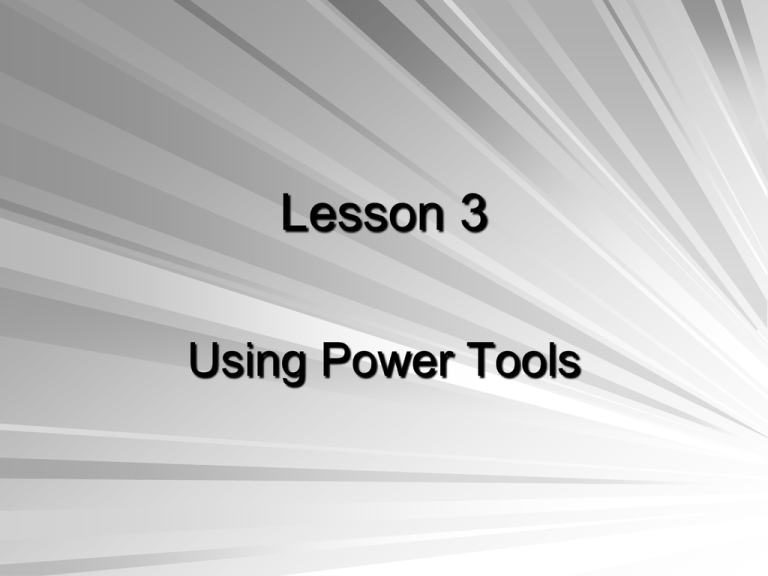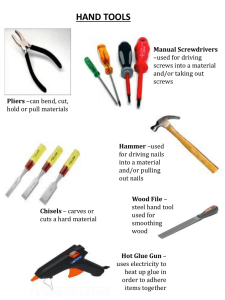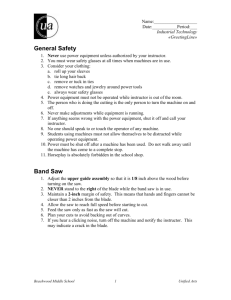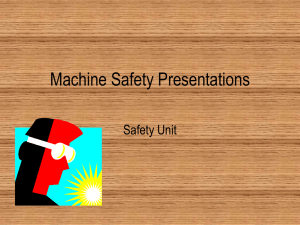Lesson A3–3: Using Power Tools
advertisement

Lesson 3 Using Power Tools Next Generation Science/Common Core Standards Addressed! CCSS.ELALiteracy.RST.9‐10.1 Cite specific textual evidence to support analysis of science and technical texts, attending to the precise details of explanations or descriptions CCSS.ELALiteracy. RST.9‐10.4 Determine the meaning of symbols, key terms, and other domain‐specific words and phrases as they are used in a specific scientific or technical context relevant to grades 9–10 texts and topics. CCSS.ELALiteracy. RST.11‐1Follow precisely a complex multistep procedure when carrying out experiments, taking measurements, or performing technical tasks; analyze the specific results based on explanations in the text2.3 Agriculture, Food and Natural Resource Standards Addressed! PST.01.02. Apply physical science and engineering principles to design, implement and improve safe and efficient mechanical systems in AFNR situations. PST.01.02.02.a. Identify the tools, machines and equipment needed to construct and/or fabricate a project in AFNR. Bell Work! Explain and compare the power sources used for power tools. Discuss power tool safety. Explain how to operate portable power tools. Discuss the operation of stationary woodworking power tools. Terminology (1) Band saw Belt sander Chain saw Drill chuck Drill press Finishing sander Ground fault interrupter (GFI) Grounding Hammer drill Hydraulic tool Jointer Miter gauge Motorized miter saw Planer Pneumatic tool Portable circular saw Portable disc grinder/sander/buffer Portable drills Portable power tools Power nail guns Terminology (2) Power staplers Power tool Push stick Radial arm saw Reciprocating saw Rip fence Router Sabre saw Scroll saw Stationary power tools Table saw Student Interest Approach Tour the shop showing the students the portable and stationary power tools available for their use. Ask students which tools they have used. Talk about the importance of knowing how to use the various tools. Touring a hardware store or a tool rental business would be helpful in seeing power tools. Use the internet to compare tools from major tool companies. Some of the major companies are Milwaukee, Delta, Black& Decker, Dewalt, and Makita. Sources of Power Power for power tools is from four primary sources: –Electricity –Fuel engines –Pneumatics –Hydraulics. Electric Powered Plug-in power tools are the most commonly used power tools. Popular Tools: –Saws, –Drills, and –Sanders Electric Powered Portable battery powered drills have become very popular. –Charger is plugged in to recharge the battery. Pneumatic Tools Uses compressed air as power for operation Pneumatic powered nailer’s and staplers are commonly used in construction. Hydraulic Tools Uses a compressed liquid to provide the power for tool operation –Usually oil Jacks, loaders, lifts, and presses are often hydraulically powered Power Tool Power Sources Reviewed Power Tool Safety Big difference between hand tools and power tools: – Power tools are more dangerous. Accidents with power tools are often more serious Improper use can result in losing an eye, finger, hand, or even your life Operator’s Manual Never operate a power tool without reading the operator’s manual. – Written description of how to safely use and maintain a power tool – Usually accompanies a new power tool. – Gives proper assembly, installation, service procedures, parts lists, and operating instructions Check out a new tool before Operator’s Manual Check out a new tool before operating it with special attention given to condition of any shields or guards. Grounding Prevents electrical shock. Electric-powered tools should be properly grounded so that if a short develops the operator will not be shocked or electrocuted. Grounded tools may be identified by the three-prong plug. Operator Responsibilities Responsible for selecting and using personal safety protection devices appropriate for the tools that are being used – Eye glasses, goggles, or a face shield are a must. – Loud tools: ear muffs or ear plugs are important. – Leather shoes with steel toes are recommended in many situations. – Some situations call for long sleeves, gloves, masks, or respirators. Tool Care Keep in good condition. Always check the condition of the tool before using it. Guards, shields, cords, and hoses should be carefully inspected. Be sure blades and bits are sharp. Sharp tools will require less pressure to make the tool function resulting in a safer situation. Safety in Using Power Tools Portable vs. Stationary Power Tools Portable power tools: Can easily be moved from job to job. – They save labor and are relatively inexpensive to buy. – Lighter and designed with handles to make them easy to use. – Tools with electric cords or air hoses are limited to areas were electricity is present. – A cordless power tool is a tool powered by electric energy stored in a battery. Portable vs. Stationary Power Tools Battery operated power tools: – Make it possible to complete work quickly and efficiently. – Purchase a second battery so that one can be charging while the other one is being used. – Portable power tools commonly used in carpentry are sanders, drills, saws, and routers. Portable vs. Stationary Power Tools Stationary power tools: Too large and bulky to move about so jobs are brought to the tool. Both are designed to do the same work. Portable disc grinder/sander/buffer Rotating disc that is used for work where the material to be ground, sanded, or buffed is too large or heavy to move to a stationary tool – Secure the work, hold tightly to the tool, wear eye protection, and dust mask. Portable Belt Sander Uses a rotating sanding belt to rapidly smooth wood. – sanders are usually used for rough sanding but the belts vary in coarseness. – Most belt sanders are equipped with a dust bag. When putting on a new belt be sure to watch the arrow on the belt so that the belt is installed correctly. Portable Belt Sander Hold with both hands and turn on the switch before the sander touches but when it is very near the surface to be sanded – Sand with the grain gently moving the sander in a straight but slightly sideways back-and-forth motion. Finishing Sander Used for final sanding Moves in a forward and backward motion or in an orbital or circular motion at a high rate of speed Move the finish sander back-and-forth with the grain of the wood until the desired smoothness is achieved – Several fineness grades of sandpaper are available. Portable Drills Usually variable speed, reversible, and sized by the maximum size hole they can drill (ex. ¼ inch, 3 /8 inch, or ½ inch) Portable Drills Procedures: –When drilling metal, first mark the location to be drilled with a center punch –Be sure to secure the work with a clamp or in a vise prior to drilling –Exert pressure to help get the twist drill to go into the material. Portable Drills Relieve the pressure as the point of the bit begins to go through the material. Drill chuck: The three-jaw part that holds the bit. –Older drills have a chuck key to tighten the bit while the newer drills are usually keyless, self-tightening. Portable Drills Hammer drill: Drill that not only turns the bit but also provides a rapid striking action on the bit to speed up drilling in masonry materials. Portable Saws Includes –Sabre saw, –Reciprocating saw, –Circular saw, and –Chain saw. Sabre Saw Has a narrow blade located underneath the base that moves up and down to cut circles, curves, and holes –Most cuts begin at the edge of the material to be cut. Sabre Saw – a.k.a jigsaw or bayonet Procedures – In cutting a hole in the middle of a piece of material, first drill a hole so that the blade can be inserted. Be sure the material to be cut is firmly held in position. – Move the saw slowly and carefully to achieve quality cuts. – Use slower speeds for metal and faster speeds for wood. Reciprocating Saw Also known as a saws-all or tiger saw Has the blade at the end, much like the chuck of a drill. Material to be cut should be carefully held in position. Portable Circular Saw Lightweight, motor-driven, roundhttp:// bladed saw used where stationary saws are impractical Most popular saw used in woodworking. Portable Circular Saw Used for crosscutting, ripping, and beveling Because of its high speed and the tendency to kick back, the portable circular saw can be a dangerous tool. Chain Saw Gas or electric powered saw used in cutting and pruning trees and cutting large pieces of lumber where precision is not important Cutting is by an endless chain that has teeth attached to links of the chain. Router Power tool with a smooth base that is moved across the material by the operator as the protruding bit turns at a high rate of speed to create grooves and ornamental shapes on the face or edge of wood Groove or cut is determined by bit’s – Type, shape, and size. Routers Dangerous Bits (Do NOT Use): – dull, rusted, or covered with gum from the wood Clean, sharp bits will provide clean even cuts if the router is held firmly to the wood. –Guides and jigs can be used to help do straight lines, circular, or contour routing. Power Nail Guns and Staplers Nail Guns: Are either pneumatic or use a battery generated spark to ignite a charge of gas to drive nails. Staplers: Like the nailers only they shoot staples. – Both have a safety mechanism that will prevent firing nails or staples unless the gun is in contact with the work to be joined. – Combination guns are available. Operating Stationary Power Tools Stationary power tools: Large machines that have a permanent location in the shop – Plan the location of each machine to allow sufficient room to work – Keep guards and shields in place. – Keep blades, knives, and bits sharp – Follow manufacturer’s recommendations for the installation, use, adjustment, and repair of each machine Operating Stationary Power Tools Use a safety tape to mark the safety zone around each machine where only the operator is allowed to stand Wear safety glasses and be sure to shut off the machine before leaving the safety zone. Drill Press Stationary drill designed for accurate and heavy drilling jobs Gives an operator an easy control mechanism for feeding the drill bit into the work Be sure to clamp the work to be drilled securely to prevent accidents. Drill Press If too much pressure is applied, the bit will overheat or break. Be sure to wear safety glasses and use a sharp bit. Pedestal and table top models are available. Table Saw Table saw:Platform or table with a circular blade where the wood to be sawed is pushed into the blade Adjust the blade depth so it protrudes ¼ inch through the material to be cut – Either the table or the blade may be tilted to cut angles Miter Gauge Miter gauge: Guide used to line up the wood to be pushed into the blade. Can be set to make square or angle cuts. – When cutting long boards they need to be supported to avoid kickbacks or pinching of the blade with the wood. Rip Fence Rip fence: Adjusted to a desired width to guide the wood being pushed through for ripping Push Stick Push stick: 12 inch long piece of wood with a notch in the end used instead of the fingers to push the wood when it gets close to the blade. – Whenever the table saw is used the guard should be in place and the kickback fingers set to touch the wood. Radial Arm Saw While the wood is held against the fence, the blade is pulled into the wood to be cut Has the motor and blade suspended on an arm over the table of the saw Blade/motor unit can be pivoted to cut angles or to rip boards Motorized Miter Saw Also called cutoff saw and chop saw Has a circular blade that is lowered into the material that is being cut – Because of its spring-loaded mechanisms once the cut is made the blade unit returns to the up position – Capable of cutting 45 to 90 degree angles Motorized Miter Saw Fine-toothed blade: Used to cut the angles for molding. Carbide tip blade: Chop saw used to cut 2× 4’s when framing a house Band Saw Band Saw: Uses a long continuous blade that moves between guides, pulleys, and wheels. Electric motor turns the drive wheel using belts and pulleys. Blade has teeth on one edge that can quickly cut material. Band Saw Used to make curved and straight cuts in wood, normally not in metal. Material to be cut is placed on the platform and pushed into the blade Care should be taken not to push the material into the blade too rapidly May be equipped with a tilting table, a miter gauge, and a rip fence The blade is moved into the metal when cutting with a band saw. Scroll Saw Scroll Saw: Table mount saw similar to the band saw only smaller with a blade that moves up and down instead of in a circle Used mostly for cutting thin material to make craft projects. Planers Has sharp knives in a wheel that turns to shave or dress the sides of boards to a uniform thickness. Excellent tool to level and smooth wide pieces made by gluing boards together Planers Once a board is started in the machine, the machine is self-feeding Be sure to carefully examine any board to be planed for freedom of nails and screws The depth of cut is the only adjustment on a planer. Trying to remove too much wood can lead to problems. Jointer Uses sharp knives fastened to a cylinder turning at a high rate of speed to straighten and smooth edges of boards and to cut bevels Jointer Potentially a very dangerous tool –Knives can inflict severe cuts and lumber may be thrown if not handled properly –Knives need to be installed so their cutting edges extend to the same height and leave the board smooth and even as the cutter head rotates. The End!




